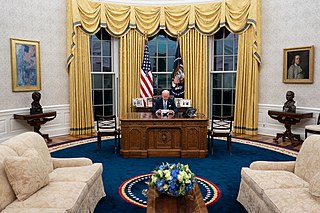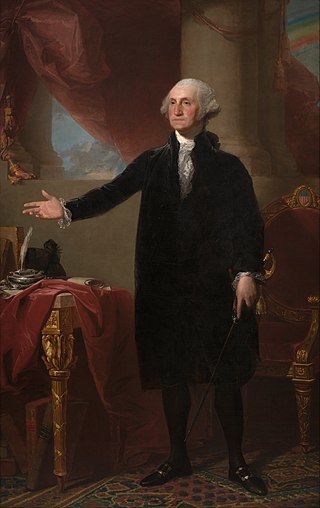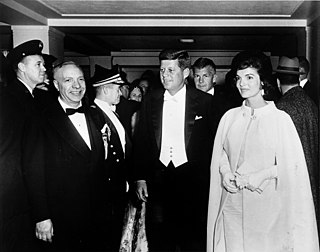
The Oval Office is the formal working space of the president of the United States. Part of the Executive Office of the President of the United States, it is in the West Wing of the White House, in Washington, D.C.
A whistle stop or whistle-stop tour is a style of political campaigning where the politician makes a series of brief appearances or speeches at a number of small towns over a short period of time. Originally, whistle-stop appearances were made from the open platform of an observation car or a private railroad car.

In political studies, surveys have been conducted in order to construct historical rankings of the success of the presidents of the United States. Ranking systems are usually based on surveys of academic historians and political scientists or popular opinion. The scholarly rankings focus on presidential achievements, leadership qualities, failures and faults. Popular-opinion polls typically focus on recent or well-known presidents.
In the United States, presidential job approval ratings were first conducted by George Gallup to gauge public support for the president of the United States during their term. An approval rating is a percentage determined by polling which indicates the percentage of respondents to an opinion poll who approve of a particular person or program. Typically, an approval rating is given to a politician based on responses to a poll in which a sample of people are asked whether they approve or disapprove of that particular political figure. A question might ask: "Do you approve or disapprove of the way that the current president is handling their job as president?"

The United States Secret Service uses code names for U.S. presidents, first ladies, and other prominent persons and locations. The use of such names was originally for security purposes and dates to a time when sensitive electronic communications were not routinely encrypted; today, the names simply serve for purposes of brevity, clarity, and tradition. The Secret Service does not choose these names, however. The White House Communications Agency maintains a list that candidates choose from, often choosing ones that resonate with them personally.

Beginning with painter Gilbert Stuart's portrait of George Washington, it has been traditional for the president of the United States to have an official portrait taken during their time in office, most commonly an oil painting. This tradition has continued to modern times, although since the adoption of photography as a widely used and reliable technology, the official portrait may also be a photograph.

The six-year itch, according to political scientists, is the pattern which takes place during a US president's sixth year in office. This year is characterized by the nation's disgruntled attitude towards the president and his or her political party. During this time, there is a midterm election and the party in power usually loses a significant number of seats in Congress.

There have been 41 United States presidential visits to Canada by 14 presidents over the past century. As the U.S. president is both head of state and head of government, these visits have taken many forms, ranging from formal state visits to official visits, working visits, or private visits.
Fifteen presidents of the United States have made thirty-four presidential visits to Mexico. The first visit by an incumbent president to Mexico was made in 1909 by William Howard Taft. It was only the second time in U.S. history that a president left the country while in office.

United States presidential inaugural balls are large social gatherings, both white tie and black tie, held to celebrate the commencement of a new term of the president of the United States. Planned and sanctioned by the Presidential Inaugural Committee, the official inaugural balls occur throughout the evening of Inauguration Day in the Washington D.C. area and are invitation-only, attended by guests who are issued pre-paid tickets. The president, first lady, vice president, and second lady or gentleman all make personal appearances at each of the inaugural balls held in their honor. Catered food, beverages, and live entertainment performed by national and globally acclaimed musicians are provided at the inaugural balls.

Thirteen United States presidents have made presidential visits to Southern Europe. Woodrow Wilson became the first incumbent president to visit a Southern European country in January 1919 in the aftermath of World War I. Visits occurring during the 1940s through 1980s were offshoots of American diplomatic interactions during World War II and then the Cold War.









